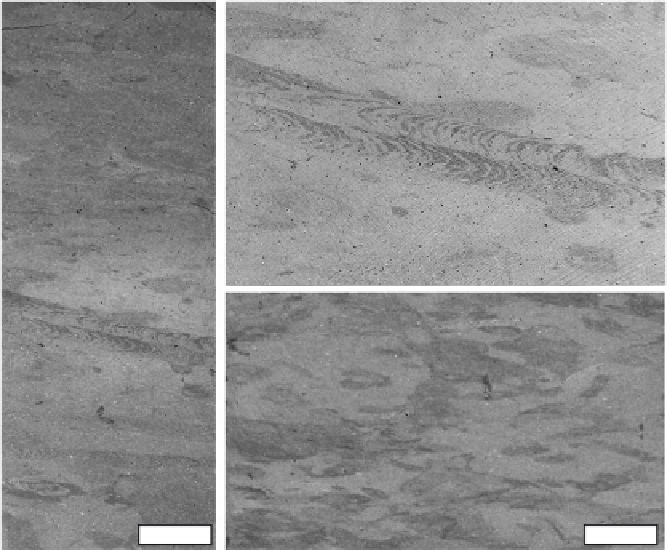Environmental Engineering Reference
In-Depth Information
A
B
Ch
Diffuse burrow
mottling
Pl
Zo
Ch
Pl
1 cm
C
Pl?
Zo
Te ?
2 cm
1 cm
FIGURE 4
Examples of ichnofabrics in deep-sea chalks and marls, Eocene, ODP core, site 1073,
Leg 174A, New Jersey margin. (A) Core section showing both diffuse burrow mottling in relatively
carbonate-poor mud (top) and distinct trace fossils in chalk (Pl;
Planolites
, Zo;
Zoophycos
, Ch;
Chondrites
). (B) Close-up of the chalk ichnofabric in A. (C) Ill-defined structures in clay-rich ooze.
Burrow mottling may include
Planolites
(Pl?) and
Teichichnus
(Te?).
(e.g., in abyssal settings below the lysocline), substrates become less cohesive.
As a result of lower sediment shear strengths, even transition-layer structures
may be significantly influenced by compaction. Consequently, in modern
deep-sea marly oozes and in some Cretaceous and Tertiary marls, ichnofabrics
are characterized by lower diversity assemblages of ill defined, typically hori-
zontal structures (e.g.,
Fig. 4
C) that cautiously may be ascribed to
Planolites
,
Chondrites
,or
Thalassinoides
(
Ekdale, 1980; Ekdale and Berger, 1978; Ekdale
and Bromley, 1982, 1984b; Frey and Bromley, 1985; Wetzel, 1991
).
Ichnocoenoses representing the
Zoophycos
Ichnofacies also vary as a func-
tion of benthic redox conditions (
Figs. 3
B and
6
). While modern carbonate ooze
and most Cretaceous and Tertiary chalks accumulated in oxygenated settings,
some pelagic carbonates accumulated beneath dysoxic or anoxic waters. These
include some deep-sea carbonates—for example, those deposited during Creta-
ceous oceanic anoxic events (
Ekdale, 1985
) or the K/T boundary interval
(
Droser and Bottjer, 1991
)—and chalks and marls deposited in stratified epeiric
basins, such as the U.S. Western Interior (
Savrda, 1998a,b
; see
Fig. 6
) and the

























Search WWH ::

Custom Search